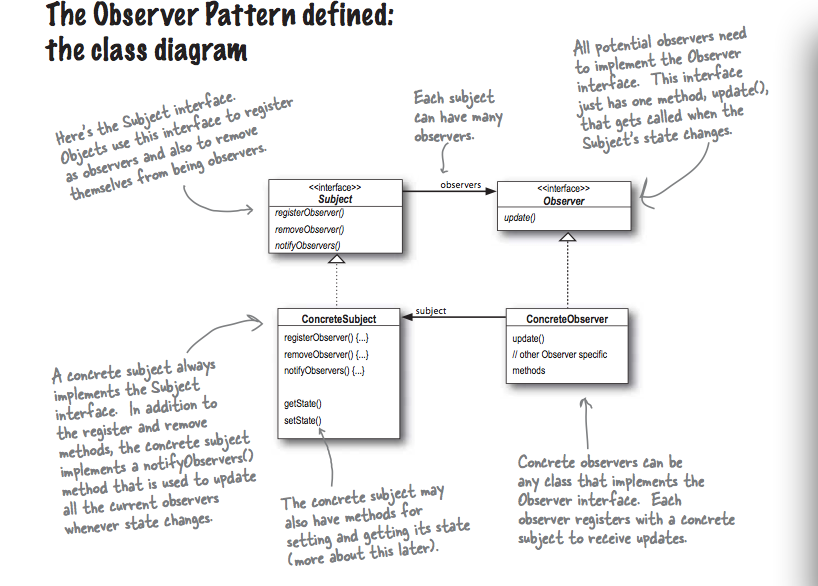设想平时的订阅报纸业务是如何进行的,可能我的描述不是非常的准确,请原谅。一份份电子报纸我们可以看作是数据源,假设是从某处得到,那么我们要订阅它,于是你可以这样来书写代码:
输出:
package headfirst.newspaper;
public class Newspaper {
//内容
private String content;
//作者
private String author;
//....其他属性
public Newspaper(){
}
public String getContent() {
return content;
}
public void setContent(String content) {
this.content = content;
}
public String getAuthor() {
return author;
}
public void setAuthor(String author) {
this.author = author;
}
//重要是这个方法,内容发生改变的时候调用
public void ContentChanged(){
subscriber1.update(content,author,....);
subscriber2.update(content,author,....);
subscriber3.update(content,author,....);
subscriber4.update(content,author,....);
}
}这样的写法表明你是在针对具体实现编程,这样的话你在程序运行时无法改变订阅者,这样的程序难以维护和复用,比较好的做法应该是针对接口编程,把可能变化的地方抽象出来,这是面向对象设计的基本准则,于是我们可以借鉴订阅报纸来思考。
我们可以订阅某份报纸,一旦报纸出版就通知我们,并提供给我们,我们也可以取消订阅,信息资料的主动权不在订阅者手中,并不是我们不断地去问报纸要,而是有了更新才通知我们。
可以借助headfirst design中的uml图来帮助理解:
代码如下:
package headfirst.newspaper;
public interface DisplayElement {
public void display();
}
package headfirst.newspaper;
public interface Observer {
public void update(String content,String author);
}
package headfirst.newspaper;
public interface Subject {
public void register(Observer o);
public void remove(Observer o);
public void notifyObserver();
}
package headfirst.newspaper;
import java.util.ArrayList;
import java.util.Iterator;
public class Newspaper implements Subject{
//内容
private String content;
//作者
private String author;
//....其他属性
private ArrayList<Observer> observer;
public Newspaper(){
observer=new ArrayList<Observer>();
}
public String getContent() {
return content;
}
public void setContent(String content) {
this.content = content;
}
public String getAuthor() {
return author;
}
public void setAuthor(String author) {
this.author = author;
}
//重要是这个方法,内容发生改变的时候调用
public void ContentChanged(String content,String author){
this.setContent(content);
this.setAuthor(author);
this.notifyObserver();
}
@Override
public void register(Observer o) {
this.observer.add(o);
}
@Override
public void remove(Observer o) {
int i=this.observer.indexOf(o);
if(i>=0){
this.observer.remove(i);
}
}
@Override
public void notifyObserver() {
System.out.println("新的内容已经发布!");
Iterator<Observer> iterator=this.observer.iterator();
while(iterator.hasNext()){
iterator.next().update(content, author);
}
}
}
package headfirst.newspaper;
public class Subscriber1 implements Observer,DisplayElement{
private String content;
private String author;
private Subject subject;
//.......
public Subscriber1(Subject subject){
this.subject=subject;
this.subject.register(this);
}
public void update(String content, String author) {
this.content=content;
this.author=author;
this.display();
}
@Override
public void display() {
System.out.println("this is subscriber1!");
System.out.println("content is "+this.content);
System.out.println("author is "+this.author);
}
public void remove(){
this.subject.remove(this);
this.subject=null;
}
public void setSubject(Subject subject){
this.subject=subject;
}
}测试代码:
package headfirst.newspaper;
public class Test {
public static void main(String args[]){
Newspaper newspaper=new Newspaper();
Subscriber1 subscriber1=new Subscriber1(newspaper);
Subscriber2 subscriber2=new Subscriber2(newspaper);
newspaper.ContentChanged("the king of the ring", "Tolkien");
}
}
输出:
新的内容已经发布!
this is subscriber1!
content is the king of the ring
author is Tolkien
this is subscriber2!
content is the king of the ring
author is Tolkien
主要内容来自headfirst design pattern,感谢这本书























 1217
1217

 被折叠的 条评论
为什么被折叠?
被折叠的 条评论
为什么被折叠?








